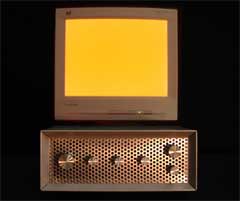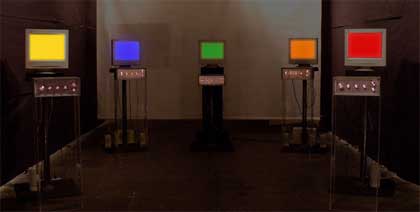 Instead of presenting complex images (computer programs or photographs) each computer of The Analog Color Field Computer (ACFC) repurposes its monitor such that a solid field of color is spread across its entire display. And instead of producing complex sounds (clicks, beeps or music) each sculpture produces a pure musical tone.
Instead of presenting complex images (computer programs or photographs) each computer of The Analog Color Field Computer (ACFC) repurposes its monitor such that a solid field of color is spread across its entire display. And instead of producing complex sounds (clicks, beeps or music) each sculpture produces a pure musical tone.
By minimizing the content of its audio-visual renderings to solid colors and pure tones, the device offers relief from the myriad of visual, sonic and operational conventions traditionally associated with computer systems. The audience can adjust the hues, pitches and rhythms of each computer and thus assume a role previously reserved for a computer’s video processor. They can manually regulate the electrical currents that command the monitor’s color circuitry. The ACFC does not employ display systems as media for the visualization of computed images, instead the aesthetic artifact is derived from the physical manifestations and electrical workings of computer monitors themselves.
The piece also points to the rate at which Cathode Ray Tube based monitors are being discarded to leave the space to the much leaner flat panel displays. The ACFC gives the screens a new life as pieces of art. As a tribute to the CRT century-old technology, the installation utilizes analog electronics almost exclusively.

A work by Gregory Shakar. More details and a video in Vague Terrain.
Related: Monochromeye, a headgear that reduces your vision to basic monochromatic color readings of the environment.
The work has been selected for the Share festival that will take place in Turin (Italy) on January 23-28.
Another nice use of “obsolete” computer screens is SE/30 :: welcome to the 20th century back!, 15 primitive computers that make music and b&w visuals by collaborating and communicating.
The installation is based upon cellular automata, algorithms based on the following principle: the state of a cell is a function of the states of neighbouring cells. A rule is chosen to determine this function. Since all cells are equal, if you choose a good rule, complex patterns emerge. Each SE/30 is a cell and adapts itself to its neighbourhood, thereby forming patterns of collaboration.
The sound is modulated and the image is plotted by the state of the computer generating it. In the realm of General Midi and Quicktime Musical Instruments, aesthetics of error are a necessity. Digital artifacts render cellular timbres into abstract textures. Movie.

